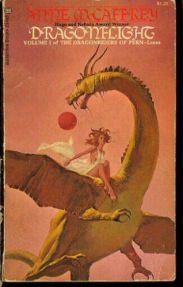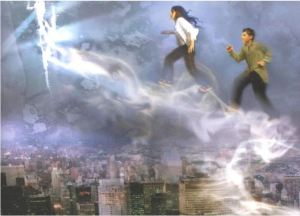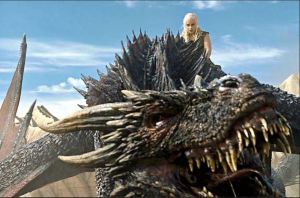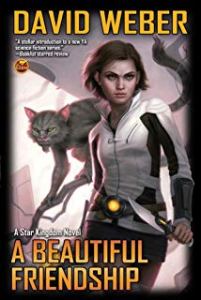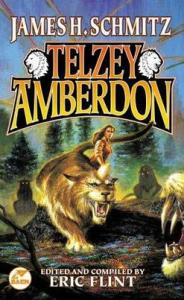Six weeks ago I complained about the lack of happily-ever-after romances in the Star Wars series. It occurred to me that it would be useful to take a look at what exactly makes for a “happy ever after” ending (“HEA” in genre romance code). What do we really mean by that, anyway?
The Thrill of the Chase
“All the world loves a lover.” We enjoy seeing stories about people falling in love, whether it’s with someone they’ve just met or by discovering someone who was always “right before my eyes.” (Unless, of course, we’re too cynical to give any credence to so vulgar and sentimental an idea; in which case it’s the trope we love to hate.) I’d call it the courtship phase of a relationship, if that term weren’t so archaic. But “courtship” does express in a useful way the stage I’m referring to, when the lovers-to-be are maneuvering around each other, trying to figure each other out, and (almost invariably, in fiction) overcoming initial obstacles to their mutual attraction.
It’s not hard to see why this is. The courtship phase includes a lot of fun stuff. We get to see the thrill of discovery, the novelty, the tentative reaching-out and missing connections, the achievement of initially establishing a base of trust and affection. There’s uncertainty and thus suspense in those first contacts. The process reminds me of the “handshaking” by which communications systems establish a protocol for exchange of information (anybody remember that windy ‘modem connecting’ sound on a dial-up connection?).
And this process is both tricky and essential. The relationship can’t move forward until the common foundation is established. I’ve quoted Lois McMaster Bujold before:
The question a romance plot must pose, and answer (showing one’s work!) is not “Do these two people get together?” but rather “Can I trust you?” Which is most certainly not a trivial problem, in art or in life. (Response to a reader question on Goodreads (10/30/2017).)
And the relationship does have to move forward. Courtship is only a prelude. It inherently looks forward to something else: a life together. (Even to “forever,” but that’s another subject.) We feel something is missing in a case like that of Romeo and Juliet, where circumstances cheat the lovers of that opportunity.
Falling in love is fun to watch. But if that’s all a character is interested in, we get the self-centered thrill addict who keeps wanting to have the same experience over and over again—as if they wanted to relive high school graduation repeatedly, Groundhog Day-style. We can’t fall in love indefinitely; eventually we have to land somewhere. Whether the story ends with a wedding or just a commitment, there has to be a conclusion.
Yet the conclusion itself is only the kickoff for the real relationship—the HEA. “Each happy ending’s a brand new beginning.”
What It Isn’t
“Happily ever after” doesn’t mean the initial thrill of falling in love lasts forever. That simply isn’t possible; human emotions can’t remain at that fever pitch. At some point, the “dizzy dancing way you feel” is going to ebb. If we expect to feel the same way always, as I’ve just noted, we’re setting ourselves up for disappointment and unnecessary disillusion. On the other hand, that thrill can always reappear from time to time. Wise couples will take steps to encourage and renew that early glamour throughout their marriage.
 Nor does HEA mean freedom from all troubles. We can put this aside momentarily to celebrate a wedding, visualizing only a life of unimpeded bliss; but real lives invariably encounter problems and difficulties. We may even want to remind ourselves of this on the occasion of union itself. When I ran across Emily Hearn’s wedding video online, I was struck by the fact that the first piece of music set to the video was Andrew Peterson’s “Dancing in the Minefields”: “And it was harder than we dreamed / But I believe that’s what the promise is for.”
Nor does HEA mean freedom from all troubles. We can put this aside momentarily to celebrate a wedding, visualizing only a life of unimpeded bliss; but real lives invariably encounter problems and difficulties. We may even want to remind ourselves of this on the occasion of union itself. When I ran across Emily Hearn’s wedding video online, I was struck by the fact that the first piece of music set to the video was Andrew Peterson’s “Dancing in the Minefields”: “And it was harder than we dreamed / But I believe that’s what the promise is for.”
Even the vision of a couple facing adversity staunchly side by side isn’t always going to be valid. We’re told that even healthy couples have their arguments and disagreements. Indeed, a couple that never disagrees may be harboring unresolved issues under the surface.
It seems to me that all these flaws or troubles can still be accommodated in the “happily ever after” archetype. Couples can recover from adversity; it can make them stronger. Even crises in a lifelong love affair can be healed or overcome. It’s the overall trend or direction, and the overall tenor of the romance, that leads us to call it “happy.” Of course, when we wish someone happiness forever, we hope that their troubles will be relatively few and their recoveries maximally joyous. But a life together need not be perfect to be “happy.”
What It Is
If the ever-after need not be perpetual bliss to count as HEA, what is it made up of? I am hardly so wise as to prescribe sure-fire ingredients for a happy marriage. But if we think about what we’d expect to see in a story that depicted a happy couple, we can point to a few things.
If it’s going to compete with the initial falling in love, being in love has to gain in depth and resonance what it loses in surface intensity and thrill. It’s “the slow and steady fire.”
What can a couple that’s been together a while do that lovers who’ve just met can’t? Consider the cumulative pleasures and joys of two people who know each other well and have learned how to please and help each other. If they continue faithful to each other and to their union, their mutual trust will grow and deepen. And the more they trust each other, the more each can express their individual strengths (and admit their individual weaknesses).
Since loving someone doesn’t consist only in having a feeling about them, but in enacting love for them, we can learn to love someone better through experience and attentive learning. I may start by giving you a gift I would like—but eventually I learn how to give you the gift you would like. Meanwhile, the sharing of memories and experiences, families, running jokes, can enrich and strengthen the bond.
All these things are compatible with the imperfections and difficulties noted above. They make up what we’d expect to see, down the road, in a story that goes beyond the courtship—a happy-ever-after.
How We Tell the Story
Because the HEA lacks the surface glitter of the falling-in-love story, we see far fewer stories depicting it. But for purposes of example and illumination, it’s very useful to see depictions of ongoing marriages.
Such mature romances can crop up in odd places. For example, in a series that goes on beyond the resolution of initial relationships, or perhaps longer than the author expected, we may see the original lovers ‘age out’ of the focus, but still have the chance to watch them practice the art of love.
 Exhibit A is Bujold’s Vorkosigan saga. The first two books in the main sequence, Shards of Honor and Barrayar, deal with Aral Vorkosigan and Cordelia Naismith, whose son, Miles, is the principal character in most of the stories. So we see Cordelia and Aral fall in love—but then we see them continue through a whole series of other tales as both parents and political prime movers on Miles’ homeworld of Barrayar. We get to see them working together in common causes, both personal and cosmic. We see their continuing affection and evident harmony. Each is so distinctive a personality that we never think of either Aral or Cordelia as merely an extension of the other; rather, they provide an ongoing example of the kind of relationship we wanted to see in their initial stories—and to which Miles aspires for himself, having that example always before him.
Exhibit A is Bujold’s Vorkosigan saga. The first two books in the main sequence, Shards of Honor and Barrayar, deal with Aral Vorkosigan and Cordelia Naismith, whose son, Miles, is the principal character in most of the stories. So we see Cordelia and Aral fall in love—but then we see them continue through a whole series of other tales as both parents and political prime movers on Miles’ homeworld of Barrayar. We get to see them working together in common causes, both personal and cosmic. We see their continuing affection and evident harmony. Each is so distinctive a personality that we never think of either Aral or Cordelia as merely an extension of the other; rather, they provide an ongoing example of the kind of relationship we wanted to see in their initial stories—and to which Miles aspires for himself, having that example always before him.
Anne McCaffrey’s Dragonriders of Pern give us another example. In the first book (as published, not chronologically), Dragonflight, we see the rocky road of the strong-willed main characters, Lessa and F’lar, to love. Both of them are so stubborn and willful that it’s hard to picture them in a peaceful marriage. And indeed, on Pern, nothing is ever entirely peaceful for long. But as more couples come and go through the long series of sequels, F’lar and Lessa remain onstage a good bit of the time. Neither is ever tamed, though they both mellow a bit. The scrappy young Lessa becomes a little steadier and more mature as she gets older and has a child, but she still retains the original fire.
I frequently refer to the classic Lensman series, but I don’t think I’ve mentioned that the final novel, Children of the Lens, shows us the lovers whose activities dominated the three middle books, Kim Kinnison and Clarissa MacDougall, as middle-aged parents a generation later. The story is so action-oriented that we don’t get to see much of the family in peace, but what we do see gives us the satisfaction of knowing that Kim and Cris have lived a happy life together (and will continue to do so). And since the surclimax (if I may invent a word for a secondary climax occurring after the main one) involves Clarissa’s use of the power of their mutual love to retrieve Kim from an otherwise unsolvable trap, it’s clear that the romantic connection consummated at the wedding in the previous volume (twenty years earlier) has not lost its fire.
 Andrew Greeley wrote a whole series of novels in which the romance is generally about falling in love. But in his O’Malley family saga, in which the titles all refer to seasons (of life), he continues the story of one such couple from the post-WWII era right through their “Golden Years.” The young lovers of A Midwinter’s Tale have to grapple with some pretty serious psychological issues themselves, as well as family drama, over the course of years. But the “crazy O’Malleys” emerge stronger from their troubles as they go on, giving us a picture of people who are always becoming more themselves as they adjust to changing circumstances.
Andrew Greeley wrote a whole series of novels in which the romance is generally about falling in love. But in his O’Malley family saga, in which the titles all refer to seasons (of life), he continues the story of one such couple from the post-WWII era right through their “Golden Years.” The young lovers of A Midwinter’s Tale have to grapple with some pretty serious psychological issues themselves, as well as family drama, over the course of years. But the “crazy O’Malleys” emerge stronger from their troubles as they go on, giving us a picture of people who are always becoming more themselves as they adjust to changing circumstances.
 There is a subgenre of family sagas—the kinds of long-running, multicharacter stories that always make me think of TV mini-series—and some of these also give us extended looks at maturing romances. In some such stories, the conflicts arise from the dysfunctionality of the family itself; Mazo de la Roche’s Jalna novels are a case in point. But in others, we can see a couple holding strong. I recently reread R.F. Delderfield’s God Is An Englishman, the first book of his “Swann saga.” His central couple, Adam and Henrietta, grow in significant ways over the course of the story. Their love waxes and wanes, but after it wanes, it always comes back. I’d count that as a HEA.
There is a subgenre of family sagas—the kinds of long-running, multicharacter stories that always make me think of TV mini-series—and some of these also give us extended looks at maturing romances. In some such stories, the conflicts arise from the dysfunctionality of the family itself; Mazo de la Roche’s Jalna novels are a case in point. But in others, we can see a couple holding strong. I recently reread R.F. Delderfield’s God Is An Englishman, the first book of his “Swann saga.” His central couple, Adam and Henrietta, grow in significant ways over the course of the story. Their love waxes and wanes, but after it wanes, it always comes back. I’d count that as a HEA.
The novella I’m just finishing up, Time Signature, takes place in the Deerbourne Inn common setting created by the Wild Rose Press. This gave me the chance to show how a secondary couple who were engaged in Amber Daulton’s Lyrical Embrace was getting along, a little later. While their appearance is brief, I enjoyed the opportunity to represent a growing post-courtship romance, even in its early years.
Real Life
For purposes of inspiration and example, of course it’s even more helpful to be acquainted with real-life successful relationships. My parents, for instance, lived long and happy lives, and despite religious and political differences, they always remained in harmony. Though they argued about many subjects, they never, so far as I know, quarreled. While their lives could not be said to be untroubled (after all, I was one of their children), I’d say they qualified as a happy-ever-after. I’m privileged to know a number of other couples whose romances have flourished over many years, on whom I’d be glad to bestow the accolade of HEA.
The accumulation of such real and fictional examples gives us the wherewithal to refute those who scoff at the happily-ever-after ending. None of the characters of our favorite romances will have perfect later lives unmarred by any suffering or any down times in their love affairs. But if we’re willing to accept that solid happiness can be consistent with life’s inevitable troubles, we can look forward with hope to a satisfactory ending for those couples who approach their lives with both realism and love.



